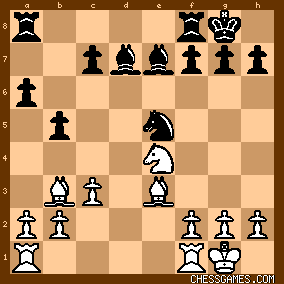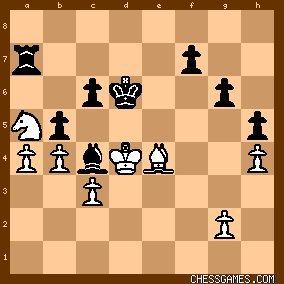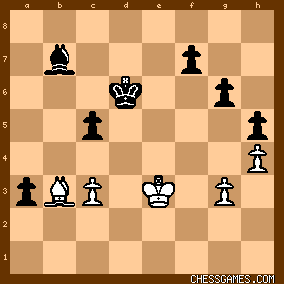May-08-08
 | | keypusher: In the previous round Lasker had lost to Marshall. Here Rosen makes Lasker work very hard, but the world champion gets the win. Losses didn't come in bunches for Lasker. He lost two in a row at Hastings 1895, but it happened to him only once more before the 1930s, to Capablanca in 1921. Like Karpov later, he was particularly dangerous right after a defeat. He lost 3 times at Nuremburg 1896, but followed each loss with a win. Ditto for the Tarrasch match in 1908. He followed his sole losses with wins at London 1899 and Paris 1900, though the London game was a bit lucky: J Mason vs Lasker, 1899. At Cambridge Springs he beat Teichmann the round after losing a brilliancy prize game to Schlechter, but was only able to draw with Barry the round after he lost the famous "revenge game" to Pillsbury. |
|
| Jul-20-17 | | iron john: 18.ke7 must be better |
|
Oct-22-17
 | | KEG: If not for some unusual sloppiness on move 31, this would have been a routine win for Lasker. He got an even position as Black in the opening (an Open Ruy Lopez), outplayed Rosen after the early exchange of Queens and probably had a won game by move 23. After Rosen missed his chance on move 32, Lasker mopped up, although a few doubtful moves made the game look superficially exciting for a while. Lasker wiped out any illusions with his neat combo beginning on Move 48. 1. e4 e5
2. Nf3 Nc6
3. Bb5 a6
4. Ba4 Nf6
5. 0-0 Nxe4
6. d4 b5
7. Bb3 d5
8. dxe5 Be6
9. Be3
Rosenthal in the Tournament Book calls this move "Weak" and opts for the more normal 9. c3. But I see nothing wrong with 9. Be3. If I were searching for an alternative, I would look at 9. Nc3. 9... Be7
10. c3 0-0
11. Nbd2 Qd7
Rosenthal prefers 11...NxN, but Lasker's move is fine. Black need not fear the exchanges which Rosen now initiates. 12. NxN
Rosen--who has played well up to this point-- decides to try his luck in an endgame against Lasker. Since Rosen has no edge in this endgame, and given Lasker's legendary strength in this phase of the game, this was not a recipe for success for Rosen. Rosen could have retained a small edge (as White) by playing the better 12. Re1 12... dxN
13. QxQ BxQ
14. Nd2
Perhaps 14. Rad1 was slightly better.
14... Nxe5
15. Nxe4
The position was now as follows:

click for larger viewAs is obvious, Rosen has lost any edge he may have enjoyed as White and has reached an even endgame. Within about 8 moves, Lasker achieved a won position. How this occurred will be covered in my next post on this game. |
|
Oct-23-17
 | | KEG: Post II
The phase of the game following 15. Nxe4 is remarkable in that Lasker quickly manages to obtain a won game (winning a pawn among other things) without any terrible blunders by Rosen. It was simply a case of a stronger player slowly but surely outplaying a less talented opponent. 15... Bc6
16. Ng3
Rosenthal in the Tournament Book claims that 16. Bc5 would not have been good, but it in fact was best for White. After 16. Bc5 best for Lasker would have been 16...Rfe8 after which chances would have been about equal. Had Lasker instead played 16...BxN as recommended by Rosenthal then Rosen would have had the better chances 17. BxB Rfe8 followed by 18. Rfe1 RxB 19. RxB. Rosen's actual move (16. Ng3) was not a losing move by any means, but he is drifting into an inferior game. 16... Nd3
Lasker immediately goes on the attack and posts his Knight deep in Rosen's territory. 17. Nf5
17. Rab1, as suggested by Rosenthal, would have been better. Sometimes the obvious defensive move is best. 17... Rfe8
18. Rab1 Bf8
19. Rfd1
Another second-best move by Rosen. 19. Ng3 was best. Rosen is still not necessarily lost, but he is getting into trouble. 19... Be4
Lasker's Bishop now threatens Rosen's b1 Rook (through the d3 Knight). Lasker's use of the Bishop on this diagonal is a theme that will haunt Rosen. 20. Ng3 Bg6
21. h4
As Rosenthal notes, 21. Bc2 would be crushed immediately by 21...Nxf2. 21... h5
22. Bd5 Rad8
23. Bf3
Now Rosen is going to lose a pawn and is almost certainly lost. As Rosenthal points out, 23. Bc6 was essential. 23... Bd6
Lasker sets a nasty little trap. At first sight, it looks as if Rosen can win the Black pawn on h5. 24. Ne2
Had Rosen tried to win the h5 pawn, he would have been blown away immediately. If 24. Nxh5 Ne5 and White is crushed. (His best chance here--insufficient as it would have been--would be 25. Be2 and certainly not Rosenthal's awful 25. Ra1 NxB+ 26. gxN BxN and wins). If 24. Bxh5 BxN 25. BxB fxB and wins as per Rosenthal. Rosen avoids Lasker's trap, but remains in big trouble. Perhaps best here was 24. Kh2 24... Ne5
25. Rbc1 Nc4
A quick look at the position shows how the game has swung in Lasker's favor. 
click for larger viewAs is obvious, Lasker is about to win a pawn. But he thereafter almost flubbed the win. How this came about will be discussed in my next post on this game. |
|
Oct-23-17
 | | keypusher: <As is obvious, Lasker is about to win a pawn. But he thereafter almost flubbed the win. How this came about will be discussed in my next post on this game.> I'm on tenterhooks! :-) (I am, really.) |
|
Oct-24-17
 | | KEG: Post III
After Lasker's 25...Nc4, Rosen's best chance was probably 26. b4 (though he would still lose a pawn). Instead, he played: 26. Rd5
Lasker now has a lovely win with 26...Nxb2, since if now 27. Bxh5 (27. Nf4 would be best though unavailing) Lasker could play 27...Nd3! 28. Rd1 Bh2+! winning the exchange and the game. But Lasker missed this opportunity and instead played 26... NxB
This is also good enough to win, but Rosen lives to fight on a little longer--and long enough for Lasker to make a more serious error. 27. fxe3 Rxe3
Lasker has won a pawn, but there is still some play in the position for Rosen. 28. Kf2
Perhaps 28. Nf4 was a little better.
28... Rde8
28...Re5 was simpler, but Lasker still has his extra pawn and a clearly winning position. 29. Nd4
29. Rcd1 was better.
29... R3e5
Lasker continues to flounder, although he still has the game in hand. 29...Rd3 was simpler and better. 30. Rd1
Rosen should have played 30. RxR. Lasker now again has a chance to close out resistance, and again misses the best line. 30... Bc5
30...f6 was clearly better.
31. Kf1
Rosen seemingly had to play 31. Rd7 if he wanted to continue. But now Lasker makes a major error that definitely jeopardized the win. 31... Bb6?
This mistake was overlooked by Rosenthal in the Tournament Book. Lasker should have played the simple 31...RxR after which his win should have been at most a matter of time. After the text, however, Rosen probably had a saving retort: 32. Nc6?
Rosen, though still down a pawn, would have had excellent chances to save the game after 32. RxR RxR 33. Bb7. After the text, Rosen falls apart, and should have lost quickly. But Lasker--as we will see--still seems to be asleep at the switch after having obtained a winning position in this game. 32... Re3
33. Nb4
Another weak move by Rosen. It is true, as Rosenthal noted in the Tournament Book, that 33. Bxh5 loses to Be4 (winning the house). But 33. Rd8 was better and might have allowed Rosen a legitimate chance to hang on for a while. After the text, however: 33... a5
34. Nc6?
34. Nd3--as Rosenthal points out in the Tournament Book--was the only chance to put up further resistance. 34... Bc2!
Crushing. White has no answer to this move, and the game should have ended right about now. 35. R1d4
The position--with Lasker to move--was now as follows: 
click for larger viewLasker has a powerful attack, he is up a pawn, and Rosen's Rook is hanging. Looks like the game is over, doesn't it! But Lasker's strange sloppiness in this game continues, and the contest continued for another 20 moves before Lasker finally closed out the game with a neat combo on move 28. While Lasker didn't blow the win from her, his careless play made the game at least superficially interesting for a while, as I will show in my next post on this game. <keypusher> Sorry for another cliffhanger, but this is as far as I can get tonight. I promise to try to complete my account of my analysis of this game tomorrow. |
|
Oct-24-17
 | | KEG: Post IV
After Rosen's 35. R1d4, the game seemed nearly over. But Lasker continued to play his won position by rote, and the game became interesting until Lasker finally woke up around move 48 and put the game away. 35... BxR
Picking up the Rook is of course sufficient to win. But the really crushing move here was 35...b4. This, however, involves calculating some complex variations over the board, so perhaps it is churlish to fault Lasker on this move. He is up the exchange plus a pawn so he probably expected Rosen to resign at any moment. But more serious sloppiness by the usually reliable Lasker was to follow, and the game soon became interesting. 36. NxB Bd3+
36...Be4 was simpler and better, but once again Lasker's move is more than adequate. 37. Kf2 R3e5
38. RxR
Rosen should have tried 38. Rd7 here. Trading Rooks makes---or should have made--Lasker's task easier. 38... RxR
39. Nc6 Re6?
This loses a pawn. Of course, Lasker is still up the exchange, but he is giving Rosen hope. 40. Nxa5 Ra6
Overlooking Rosen's next move, and the beginning of a shockingly bad plan by Lasker by means of which his Rook gets trapped. It is hard to believe that this phase of the game was actually played by Lasker. 41. b4 g6
I can't believe Lasker played this move, since now his Rook gets trapped. He of course didn't need to defend the h5 pawn and should simply have recognized that he had blown a pawn and gone on to win with his exchange plus by playing 41...Re6 (or even 41...Rd6). If then 42. Bxh5 then Lasker would play 42...Rh6. 42. Bc6!
Lasker's Rook now appears to be trapped. Incredible! As will be seen, Lasker has a way out of this mess. But he doesn't appear to have gotten his head back into this game until about move 48. 42... Kf8
43. Ke3 Bc4
44. a3 Ke7
45. Kd4 Kd6
Another lazy move by Lasker. He should have played 45...Bf1 or 45...Rb6. 46. Bb7
Rosen sets a trap for Lasker here. But Lasker seems to be waking up, an spots the trick. 46... Ra7
Had played 46...Rb6 here, Rosen would have been back in the game with 47. NxB+ bxN 48. Bd5! winning another pawn. Now, Lasker is about to unleash some threats of his own. 47. Be4 c6
48. a4
Rosen misses the winning combination Lasker has seen. In fairness to Rosen, however, it is doubtful that he could have saved the game even with the "better" 48. Nxc6 Rxa3. Rosen did apparently notice that 48. Bxc6 loses immediately to 48...RxN!. But after the text, Lasker has a similar combination that brings the game to a close. The position was now:

click for larger view48... RxN!!
A beautiful winning endgame combination by Lasker. The giant has arisen from his slumbers! 49. bxa5 c5+
50. Ke3 bxa4
The rest is easy.
51. a6
51. Kd2 was of course better, but hopeless.
51,,, Bxa6
52. Bc2
A useless move. If Rosen wanted to play on, he had to try 52. Kd2 here. 52... a3
53. Bb3 Bb7
54. g3
The position was now as follows:

click for larger view54... Ke5!
A final pretty maneuver by Lasker. If now 55. Bxf7 Bd5! ends the game. 55. c4 Be4
56. Ba2 f6
0-1
A wonderful finish by Lasker. |
|
Oct-24-17
 | | keypusher: <KEG> thanks, I look forward to looking at these notes carefully. |
|
|
|
|





